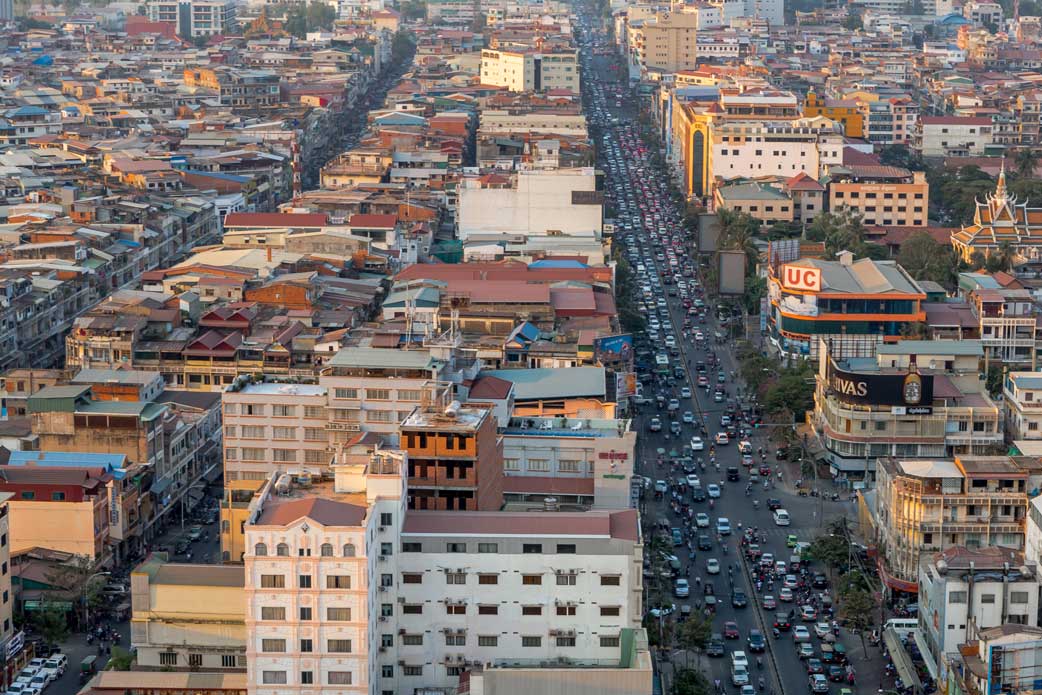It’s easy to believe that tourism to Cambodia is relatively new, but it’s not the case. In the 20s and 30s, Phnom Penh and the ancient ruins of Angkor Wat were attracting cultured travellers from Europe, including the likes of W. Somerset Maugham, Noel Coward, and even stars of Hollywood’s silver screen such as Charlie Chaplin and his entourage. Today, they would barely recognise this burgeoning city, its streets clogged with motorcycles and SUVs, and gleaming new buildings reaching skyward, but a few architectural gems from the era of glitz and glamour do remain.
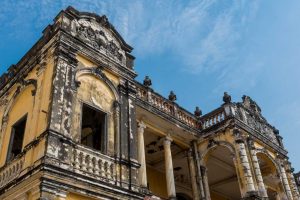
Colonial Era Architecture
Cambodia’s rich history and culture has bestowed it with a diverse collection of visually striking buildings. Like all colonisers, the French imposed their architectural style on Cambodia, and it is these villas, markets, shophouses and local administration buildings that make the biggest impression on visitors. Many have been lost or are almost beyond saving; some are simply in need a little sympathetic restoration, while others have already been returned to their former grandeur. There are architectural gems in all states of repair in provincial towns across the country but some of the most impressive are located in the capital city, Phnom Penh. Walking tours that take in all the highlights are a great way of discovering the city and its history.
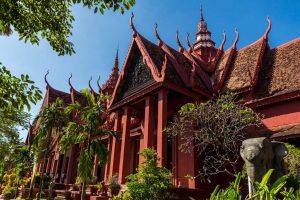 National Museum
National Museum
There can be few sights that encapsulate the essence of Asian exoticism more than the silhouette of Phnom Penh’s National Museum at sunset. Yet this quintessentially Khmer structure was designed by the French artist, author, historian, educator and ethnologist, George Groslier (1887-1945). In addition to the art school he also proposed building a museum and the creation of an organisation dedicated to preserving craft knowledge. Groslier’s vision was soon realised, and the Musée Albert Sarraut was officially opened on the Khmer New Year, 14th April 1920.
Central Market
Psar Thmei, more commonly known as the Central Market,
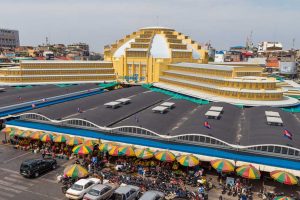
is a city landmark and one of the finest Art Deco period buildings in Southeast Asia. At the site where the market now stands there was once a lake formed by excavations for earth to build the hill on which Wat Phnom stands. When plans for the market were drawn up by the architect Jean Desbois, the French drained and filled the lake. Construction of the market began in 1935 and was completed just two years later. Cleverly designed to be light, airy and cool, the market features four covered wings that lead to a central 26-metre high and 30-metre wide dome. The market, which houses gold traders, clothing vendors, food stalls, flowers sellers and a fresh market, was renovated in 2011.
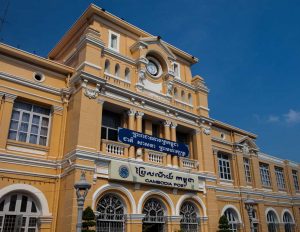 The Post Office
The Post Office
The Post Office in Phnom Penh dates from 1895 and is one the city’s finest surviving colonial-era buildings. Situated in the heart of a district once known as the French Quarter, it was designed by Daniel Fabre. It benefitted from extensive renovations in 2004 and still serves its original purpose as a post office. Other grand buildings in the surrounding area include the former police headquarters which is believed to have been built in 1925, and the former Bank of Indochina which has been transformed into an upscale European restaurant.
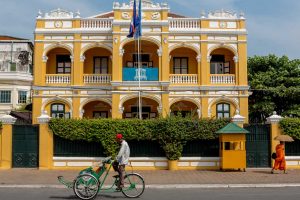
The UNESCO Building
The restored UNESCO building was constructed between 1910 and 1920 and was once the residential villa of a wealthy Chinese merchant. Located on Samdech Sothearos Boulevard facing Mount Meru Square in front of the National Museum, it is one of a several colonial-era villas in the area and was a family home until the Khmer Rouge marched into Phnom Penh in 1975. From 1979 until 1989 it came under the control of the Vietnamese Military City Police who used it as their headquarters before eventually opening as the UNESCO office at the end of 1991.
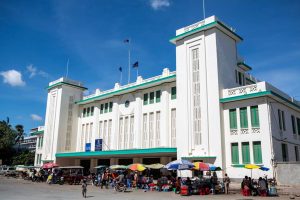 The Royal Railway Station
The Royal Railway Station
Built in 1932, the Art Deco architectural style of the Royal Railway Station reflects that of the Central Market. The station was originally built to serve passengers traveling to Battambang. Cambodia’s railway was abandoned many years ago but is currently being modernized. It is said that following the Fall of Phnom Penh in 1975 to the Khmer Rouge, the leadership held meeting here and made the decision to evacuate the city.
Raffles Hotel Le Royal
The Raffles Hotel is one of Asia’s most venerable and prestigious properties. The original plan for a hotel to be known as Le Royal was proposed in 1923 while Cambodia was under French occupation. The architect, Ernest Hébrard, who also worked on city plans for Phnom Penh, designed the 54-room Le Royal, along with a sister hotel in Siem Reap to accommodate visitors to Angkor, and another property in Vietnam’s historic town of Hué.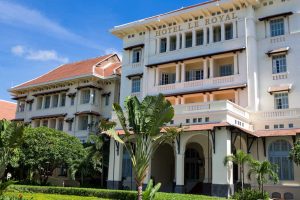
Construction began on a small parcel of land on the corner of Avenue du Maréchal Joffre (now known as Rukhak Vithei Daun Penh or Street 92) in the then fashionable European Quarter of the city. At the time. the area was bordered by canals on three sides but these were filled in during the 1920s as part of Hébrard’s ambitious plans. The project also included the creation of the tree-lined avenue that fronts the hotel and leads to Wat Phnom, and the construction of Psah Thmei, the extraordinary Art Deco central market, both of which remain today and continue to give the city its special character.
Le Royal officially opened on November 20, 1929 with a decadent party attended by His Majesty Sisiwath Monivong and leading dignitaries from the expatriate community who enjoyed a buffet, dance, and music from an orchestra brought in from Saigon to mark the occasion. Today, it is managed by AccorHotels and known as Raffles Hotel Le Royal. This luxurious Phnom Penh hotel is an essential experience for visitors to the city. You don’t have to be a guest to experience it. The nightly Happy Hour at the venue’s Elephant Bar is an institution among the expatriate community, particularly on a Friday evening. The Elephant Bar’s signature cocktail celebrates the visit of Jackie Kennedy in 1967. It is said that when the hotel was renovated, the glass from which she drank a Champagne cocktail was found, still with her lipstick on it. Hence, the Femme Fatale was created using a blend of Champagne, Crème de Fraise Sauvage, and a splash of Cognac.
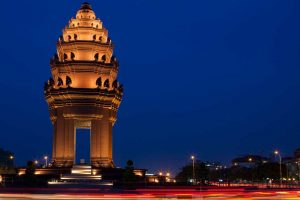 Monument of Independence
Monument of Independence
The Monument of Independence or Vimean Ekareach not only commemorates independence from the French which was granted on the 9th of November 1953, it is also a memorial to Cambodia’s war dead. The impressive 20-metre high structure stands proudly at the centre of one of Phnom Penh’s busiest intersections, the junction of Sihanouk and Norodom boulevards. It was designed by Cambodia’s most celebrated architect, Vann Molyvann and completed five years after independence in 1958. Vann drew on the heritage of Angkor to create what is surely one of the world’s most potent and assertive statements of independence. Built from red sandstone, the design is in the form of a stylized lotus bud embellished with more than one hundred heads of the mythical naga snake.



 ລາວ
ລາວ